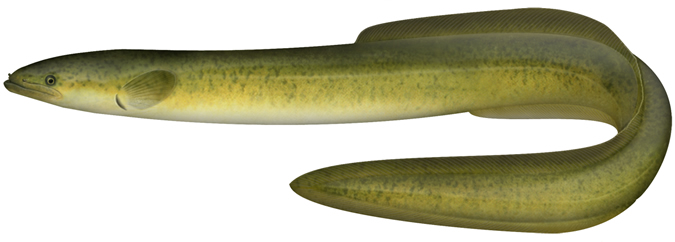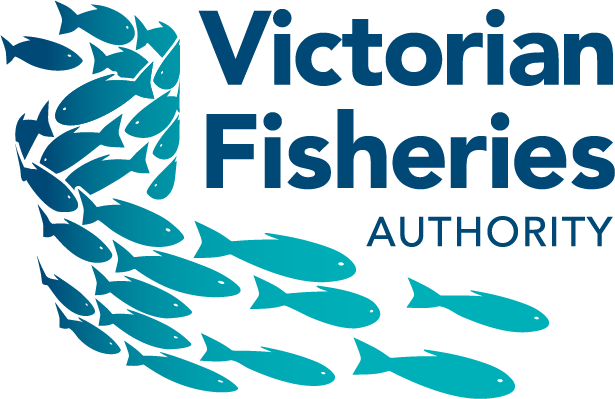Long-finned eel

| Common Name: | Long-finned eel |
| Other Name/s: | Spotted eel, "Conger eel" (wrongly) |
| Family: | Anguillidae |
| Scientific Name: | Anguilla reinhardtii (Steindachner, 1867) |
| Origin: | Native |
Description
Long, tubular body with dorsal, tail and anal fins forming one fin. Small gill opening on each side of the head. Broad head with thick fleshy lips. Large mouth extending back behind the eye. Dorsal fin starts well ahead of the anal fin. Colour of sides and back varies from olive-green to brownish with distinct blotching or mottling. Sides and belly are paler. When migrating seaward adults lose their spots and become bright silver.
Distribution
Common and widespread in eastern Victoria, south of the Great Dividing Range, east from Wilsons Promontory. Very rarely seen in other areas of Victoria.
Habitat
Although known to occur in a variety of habitats, it is reported to occur more often in rivers than in still waters.
Brief Biology
Reported to attain 2 m in length and more than 16 kg in weight. Generally individuals are much smaller, although lengths to 1 m are common. Principally carnivorous although some plant material is eaten. Large adults take a variety of prey ranging from insects to fish, although fish appear to be the main component of the diet.
Individual food items may be quite large, including one observation of a freshwater catfish of 1 kg being attacked. Feeding patterns follow the seasons and is most intense at night during spring and summer. Upstream migrations of glass eels occur from January to May. Spends most of its life cycle in freshwater and migrates downstream to spawn at sea when sexually mature.
Other Notes
Good angling fish because of its size, the long-finned eel is taken easily at night on baited hooks. Less commercially important than the short-finned eel.
Further Notes (Both Species)
Full details of the life cycle of Australian eels are still not fully understood. Both eels are believed to spawn in the Coral Sea near New Caledonia. The transparent larvae (known as leptocephali) may spend 2 to 3 years at sea being transported southwards by the East Australian Current. They then change into glass eels (no pigmentation), lose their teeth, cease feeding for a period and move into estuarine areas.
Movement into freshwater is accompanied by increased size and rapid colouring, and they are now known as elvers. Upstream migration appears to be in response to a number of factors including falling salinity and rising water temperatures. Upstream migrations in Victoria occur from May in the east to October in the west. Migration usually occurs at night, the young eels remaining close to the banks and avoiding fast flowing water.
Groups of elvers frequently attract attention when they congregate at stream barriers such as weirs, dams or waterfalls. Many individuals overcome major barriers such as high, vertical, concrete, dam walls by climbing, adhering to the damp surfaces by friction and surface tension and undulating their bodies to move forward. Eels can travel across damp ground.
Regulations
Recreational Fishing Licence requirements, and regulations affecting the taking of eels in Victoria, are provided in the Victorian Recreational Fishing Guide, available free from RFL sales agents and DEDJTR Offices and Information Centres.
Further Reading
- A Guide to the Freshwater Fish of Victoria, Phillip Cadwallader & Gary Backhouse, Department of Conservation and Environment.
- Australian Freshwater Fishes, John R. Merrick & Gunther E. Schmida.
- Biological Information for Management of Native Freshwater Fish in Victoria, J D Koehn, W G O'Connor.

